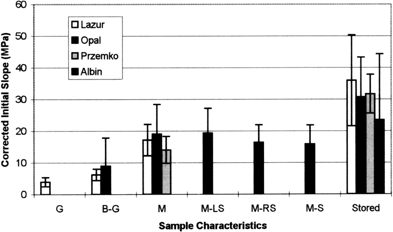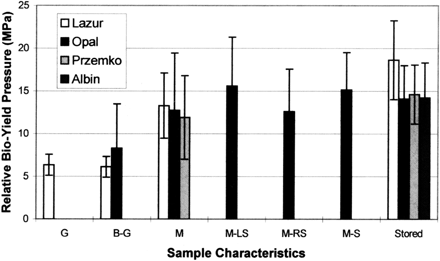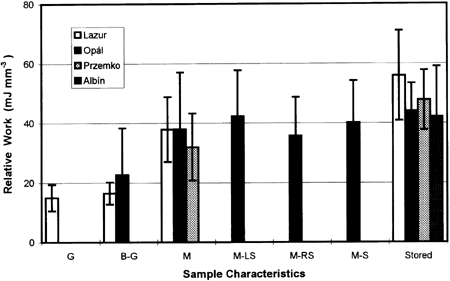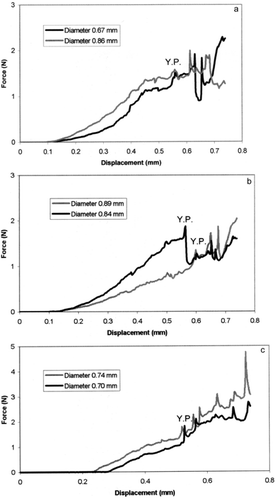ABSTRACT
Poppy seeds of four varieties (Lazur, Opal, Przemko, and Albín) were compressed between two rigid plates at constant deformation rate 0.0167 mm per second. The experiments were performed with the stored seeds, but blue varieties Lazur, Opal, and Przemko were tested also at the harvest and pre-harvest stages of maturity. The influence of three different desiccation procedures was inspected at variety Opal. The parameters of the deformation curves: the initial slope and the parameters characterising the bioyield point were changed significantly during the poppy maturity and ripening. The main changes were observed in the period, in which poppy capsules changed their colour from green-brown to brown. On the other hand no significant influence of the desiccation process was observed. The behaviour of poppy seeds during the deformation test was discussed in relation to rancidity of poppy seeds caused by mechanical damage during harvesting.
INTRODUCTION
Poppy seed is very important component of many Centre-European foods. In Austria Steidl and GreslCitation[1] estimate its consumption 1700–2300 tons per year, from which about 30 per cent goes to bakers, 40 per cent to oil and food industry and 30 per cent directly to food retailers. The high nutritional value of the poppy seeds consists in oils of the highest nutritional quality. The oil content in seeds varies usually between 26 to 52 per cent.Citation1-2 Most of the fatty acids in poppy seeds belongs to the unsaturated type [mainly oleic and linoleic acids – see Citation[3] and Citation[4]. Among the saturated fatty acids, the higher content was observed only for the palmitic acid.Citation3-4] Moreover, the excellent taste of processed poppy seeds forms the basis of the characteristic harmony of many Centre-European bakery products as cakes and other different pastries.
The high content of unsaturated fatty acids in poppy seeds is the main source of nutritional quality, but it is also the source of danger when it deteriorate.Citation[5] Oxidation of fat is frequently alluded to as autooxidation because the rate of oxidation increases as reaction proceeds. Unless mediated by other oxidants or enzyme systems, oxidation proceeds through a free-radical chain reaction mechanisms, involving three stages: i) initiation – formation of free radicals, ii) propagation, with free-radical chain reactions, and iii) termination with formation of the non-radical products. Hydroperoxides are the major initial reaction products of fatty acids with oxygen; these are lately followed by peroxy radicals and hydrocarbon radicals. Taste and odor of the products containing the above mentioned radicals show rancid.
The danger of fat oxidation and rancidity is very high in the case of poppy seeds. Ingress of oxygen causes damage by initiating oxidation process inside the seeds. This damage during mechanical operation is most danger for poppy seed quality. The degree of mechanical damage during poppy harvesting depends not only on technical parameters and regimes of harvesting machines, but also on the properties of seeds. Generally it depends on the poppy variety, water content and its degree of maturity. The susceptibility of individual plant products to mechanical damage can be determined in special mechanical tests that are usually performed on the universal testing machines (UTM). Most of these tests consist in determination of so called Firmness, the parameter expressing product ability to overcome its mechanical loading.Citation[6] Under the term firmness different mechanical parameters are understood, e.g., modulus of elasticity, bioyield force or stress, mechanical strength etc.
In case of seeds, compression of single individuals between two platesCitation[6] – in special cases see e.g., for winter rape,Citation[7] and for pea seedsCitation[8] – are usually used as a method for determination of the seed resistance to mechanical damage. Poppy seed is small and fine product (diameter about 1 mm) that can be damaged by forces about hundred-times lower than the forces causing damage of the usual seeds.Citation6-8 The direct data for mechanical properties of poppy seeds represent unknown area, no representative data of this type were found.
The compression test between two plates was used in this paper to study of mechanical properties of single poppy seeds of different varieties that were manually harvested in different stages of maturity. The main aim of this activity is monitoring the mechanical properties of poppy seeds that could serve as a basis for estimation the harvesting damage level at poppy seeds of different varieties and different stage of maturity.
MATERIALS AND METHODS
Material
Tested material was supplied by Department of Plant Production (Faculty of Agronomy) of Czech University of Agriculture in Prague. Poppy plants were cultivated on experimental fields near Cerveny Ujezd (Central Bohemia) with using the basic agronomy. Scheme of experimental material is given in Table . Some parts of Opal were chemical ly desiccated. Water solutions of Liberty (2 l per ha), Spodnam (1.25 l per ha), and Raundap (3 l per ha) were used. Capsules were harvested manually, quickly transported to laboratory where they were manually opened by cutting.
Table 1. Scheme of Tested Varieties
Test
Single seeds were compressed between two rigid plates Citation[6] at deformation rate 0.0167 mm·s−1 up to final height 0.25 mm using the Universal Testing Machine Instron (type 4464). An universal load cell (with maximum force 10 N) was used for force measurement during the whole test. The deformation curves (Fig. ) were analyzed evaluated using the Instron software (Series IX). The first 0.02–0.05 mm deformations of nonzero and nonwavy part of deformation curve were used for determination of its initial slope. Linear regression analysis was used for this purpose. The beginning of deformation curve was located at the cross point of the regression line and the displacement axis. This point served to determination of real deformations of the tested seeds. Moreover, the beginning of deformation curve served also to determination of the seed diameters. The bioyield points were determined at the first peak of the force-displacement curve when seed becomes weakened (see Figs. a, b, c). The bio-yield point was characterised by the corresponding deformation and force, and work done during deformation up to the bio-yield point.
Data Recalculation
Dimensions of the tested seeds were different (mean values 0.7–0.87 mm used in our study). The parameters obtained were modified with the aim to reduce the role of different dimensions of the tested seeds. Poppy seed was considered as a sphere of diameter d using Hertz's contact theory.Citation[9] Absolute values of deformation x were recalculate to relative values ϵ=x/d. The measured forces F were recalculated to mean pressures p at the contact areas between plates and seeds:
RESULTS AND DISCUSSION
The deformation curves were obtained reproducibly and in many cases the parallel deformation curves was observed (Fig. c). This similarity of single deformation curves contains not only the basic trends of the curves, but also by micro-structural effects observed in very similar structure of the observed micro-peaks. The initial part of deformation curves had typical concave shape of Hertzian contact deformation (F∼x3/2) only for low matured seeds (stages G and GB–see Figs. a, b). For matured or stored seeds the initial parts of the observed deformation curves are rather linear and of much higher slope. The bio-yield point parameters characterised the deformation state at which seeds started to flow and the first indications of the seeds' damage could be observed.Citation[6] The final stage of new seed hardening was described by maximum deformation and by maximum force. Mean values of the measured and recalculated parameters are presented in Table . All the parameters strongly depends on the maturity stage, level of significance is higher than 0.999. The diameter of the green capsules seeds was less than diameter of green-brown capsules seeds. This indicates possible growth of seeds in this stage. The observed decrease of seed diameter in the further stage (between GB and M) was connected with decreasing water content in this stage (Table ). Significant differences in diameter of seeds of different varieties, as well as of different desiccation procedure, were not observed. The seed diameters seem to increase during their storage (Fig. ), but this increase is not significant on 95%.
Figure 2. Mean values of seed diameters for the tested samples. The bars denote standard deviations of the samples.

Table 2. Mean Values of the Measured and Recalculated Parameters (LSD–Least Significant Difference)
Other measured and recalculated parameters behaved very similarly. They were approximately stable between stages G and BG. Their main changes were observed between stages BG and M: their substantial increase is displayed in Fig. (recalculated initial slope), Fig. (relative bio-yield pressure), and Fig. (relative deformation work performed prior bio-yield point). These results indicate that poppy seeds hardened mainly in last stage before their maturity. Only small differences were determined in the measured and recalculated variables that were obtained for the matured poppy seeds harvested from plants with different forms of desiccation or without desiccation. Lower values (95% significant level) of initial slope were observed for plants desiccated by Spodnam and combination of Raundap and Spodnam. Higher values were observed for maximum force for plants desiccated by combination of Liberty and Spodnam. Higher values of yield force were also observed for the plants desiccated by combination of Liberty and Spodnam, and Spodnam.
Figure 3. Mean values of Recalculated Initial Slopes for the tested samples. The bars denote standard deviations of the samples.

Figure 4. Mean values of Relative Bio-Yield Pressure for the tested samples. The bars denote standard deviations of the samples.

Further increase of all the studied parameters was observed after drying and short time storing; this increase is expressed by differences of the values obtained in stages M and S. In most cases this increase was lower than differences between the corresponding values in stages M and BG. The only one exception from this rule was the initial slope (Table ). In this case the increase about 100 per cent was observed for both the stages: GB-M and M-S. Only small differences in the measured and the recalculated parameters were observed for poppy seeds of different varieties (Figs. The maximum of them were observed after storing, where the significant higher values were observed for Lazur (initial slope and relative yield pressure).
Figure 5. Mean values of Relative Work up to Bio-Yield Point for the tested samples. The bars denote standard deviations of the samples.

The results showed that the main source of poppy seeds strength consists in the stage of maturity of the seeds. Some part of this influence can be formed by water content, which decreased during increasing maturity (Table ). This basic trend was not principally modified either by desiccation or by different varieties to be studied. The seed damage extent in some real mechanical process has to depend on strength of the seeds, so that the most severe mechanical damage should be avoided at unmatured seeds. In this case also the danger of oxidation of seed fatty acids is higher than at matured seeds. The process of fatty acids oxidation can be also influenced by some further circumstances taking part in chemical kinetics of the reaction. These are water content, seed temperature, oxygen concentration, enzyme concentration, etc. In every cases, even oxidation of very small part of the product fatty acids causes severe damage of the product quality. It means that every harvesting or processing technology for poppy seeds of higher quality should exclude from the mechanical operations all the seeds of lower maturity.
CONCLUSIONS
Compression of poppy seeds between two rigid plates gives reproducible deformation curves with seed weakening close to bioyield point and systems of local micro-peaks at higher deformations. The curves have characteristic Hertz-like power character only for low deformations of the non-matured seeds. The test parameters, especially the initial slope, bioyield force (bioyield pressure), and deformation energy up to bioyield strongly increase (about 100%) in the last stage prior their maturity (in time between green-brown and brown capsule colours). During storage, the similar increase was observed only for the initial slope. The effects of variety and plant desiccation on the mechanical parameters are lower than the effect of maturity. Our experiments show that the poppy seeds are susceptible to mechanical damage and the fatty acid oxidation in stage prior their full maturity. In further study the fatty acid oxidation could be studied as a function of mechanical properties as well as water content, O2 concentration, enzymes level etc.
ACKNOWLEDGMENTS
The author would like to thank to Mr. Pavel Cihlár˘ (Department of Plant Production, Faculty of Agronomy, Czech University of Agriculture) for supplying the raw material for this study.
REFERENCES
- Steidl , A. and Gressl , M. 1992 . Cancenpotentiale für O¨sterreichischen Mohn (Potential Opportunities for Austrian Poppy Seed) . Forderungsdienst , 40 ( 12 ) : 81 – 88 .
- Bajpai , S. , Prajapati , S. , Luthra , R. , Sharma , S. , Nagvi , A. and Kumar , S. 1999 . Variation in the Seed and Oil Yields and Oil Quality in the Indian Germplasm of Opium Poppy Papaver Somniferum . Genetic Res. Crop Evol. , 46 ( 5 ) : 435 – 439 .
- Singh , S.P. , Shukla , S. , Khanna , K.R. , Dixit , B.S. and Banerji , R. 1998 . Variation of Major Fatty Acids in F8 Generation of Opium Poppy (Papaver Somniferum X Papaver Setigerum) Genotypes . J. Sci. Food Agric. , 76 ( 2 ) : 168 – 172 .
- Singh , S.P. , Shukla , S. , Sudir , S. and Singh , N. 1998 . Genetic Divergence in Relation to Breeding for Fatty Acids in Opium Poppy (Papaver Somniferum L.) . J. Gen. Breed , 52 ( 4 ) : 301 – 306 .
- Dugan , LeRoy Lipids. Jr. 1976 . Principles of Food Science Edited by: Fennema , O.R. 139 – 203 . New York : Marcel Dekker Inc. .
- Mohsenin , N.N. 1970 . Physical Properties of Plant and Animal Materials – Structure, Physical Characteristics, and Mechanical Properties New York : Gordon and Breach Science Publishers .
- Davison , E. , Middendorf , F.J. and Bilansdki , W.K. 1975 . Mechanical Properties of Rapeseeds . Canadian Agricultural Engineering , 17 ( 1 ) : 50 – 54 .
- Dobrzanski , B. and Szot , B. In Proceedings of the 4th International Conference Physical Properties of Agricultural Materials and their Influence on Technological Processes . Rostock . Sept. 4–8 1989 , Germany. Strength of Pea Seeds During Compression. , Edited by: Hellebrand , J. pp. 144 – 148 . Academy of Agricultural Sciences of the German Democratic Republic Berlin .
- Johnson , K.L. 1987 . Contact Mechanics Cambridge : Cambridge University Press .
- Barreiro , P. 1999, . Detailed Procedure for Fruit Damaging . ASTEQ CA Newsletter , : 3 – 5 . No. 2
